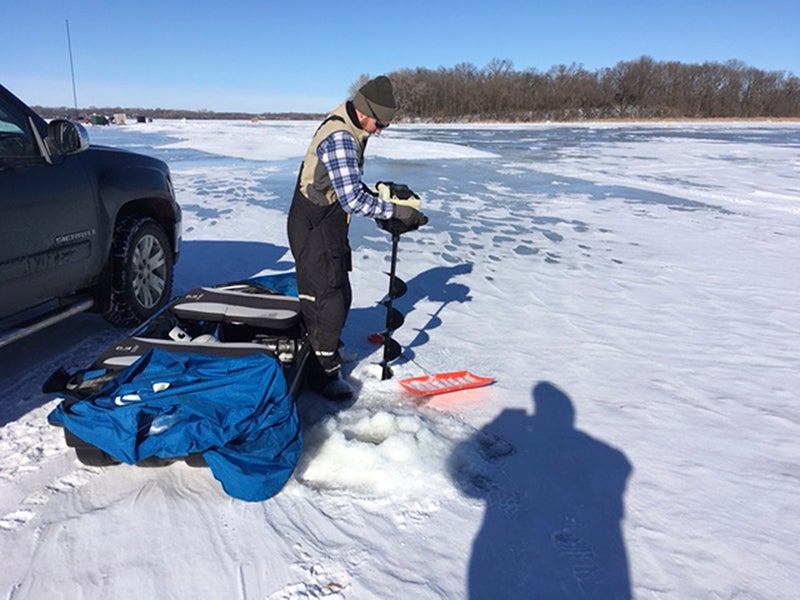Dick Herfindahl: Don’t venture out until you know the ice is safe
Published 10:00 pm Friday, November 16, 2018

- Drilling holes close to your vehicle is a good way to tell if the ice is safe enough to hold it; if water starts coming up through the holes, you should move your vehicle. - Provided
Woods & Water by Dick Herfindahl
Although I never did get in that one more-one more cast on open water, I do have plans to do a little ice fishing if my grandson Trevor gives me an invite again this year. I have fished with him at least one or more times for each of the past few years. My ice fishing skills seem to leave a lot to be desired, but this past winter I did manage to catch a few sunnies and perch. I won’t go into the details when it comes to size, but let’s just say that it was fun.
Each year we have folks who want to be the first to venture out on new ice. I like fishing and also like to eat them, but is it really worth risking your life over?
Rules to go by for new, clear ice only:
UNDER 4” – STAY OFF
4”-Ice fishing or other activities on foot
5”-7”- Snowmobile or ATV
8”-12”- Car or small pickup
12”-15” – Medium truck
Many factors other than thickness can cause ice to be unsafe.
White ice or “snow ice” is only about half as strong as new clear ice. Double the above thickness guidelines when traveling on white ice.
Checking ice thickness
Before heading out on ice, contact a local bait shop or lakeside resort to ask about ice conditions. Check ice thickness once you get there.
Temperature, snow cover, currents, springs and rough fish all affect the relative safety of ice. Ice is seldom the same thickness over a single body of water; it can be two feet thick in one place and one inch thick a few yards away. Check the ice at least every 150 feet.
There are different ways that you can check ice thickness.
Use an ice chisel, which is a metal rod with a sharp, flat blade welded onto one end. Drive the chisel into the ice using a stabbing motion to create a hole. Next, measure ice thickness with a tape measure.
The next is an ice auger. There are three different kinds of augers: hand, electric and gas. Hand augers are low cost, lightweight and quiet. Electric augers are also quiet, but use less manual labor than a hand auger. Gas augers drill through ice the fastest, but are heavier, noisier and generally more costly than hand or electric models. After drilling a hole with the ice auger, measure ice thickness with a tape measure.
Using a cordless drill and a long, five-eighths inch wood auger bit, you can drill through eight inches of ice in less than 30 seconds. Most cordless drills that are at least 7.2 volts will work, but the type of bit is critical. You need a wood auger bit since they have a spiral called a “flute” around the shaft that metal drilling bits don’t. The flutes pull the ice chips out of the hole and help keep it from getting stuck, much in the way a full-sized ice auger works. After drilling a hole, measure ice thickness with a measure tape. Dry the bit and give it a quick spray of silicone lubricant after each use to prevent rust.
Additional tips
Cars, pickups or SUVs should be parked at least 50 feet apart and moved every two hours to prevent sinking.
Make a hole next to the car. If water starts to overflow the top of the hole, the ice is sinking and it’s time to move the vehicle.
All of the precautions that the DNR puts out each year may seem like overkill and there will always be “that guy” who thinks that it won’t happen to him because he’s been pushing the envelope for years. Don’t be that guy!
Until next time, be sure that the ice is thick enough before you venture out. There is still plenty of deer hunting to be done if you are a bowhunter who’s season ends on Dec. 28th or a muzzleloader who’s season runs from Nov. 24-Dec.9th. The small game season for squirrel and rabbit is open until 02/28/2019 and taking a drive in the country at this time of the year is one of my favorite things to do. In some way at this time of the year nature seems to give me a sort of closure, almost like closing a chapter in a book.
Take some time to remember those who served their country so that all can enjoy the freedoms that we have today.




